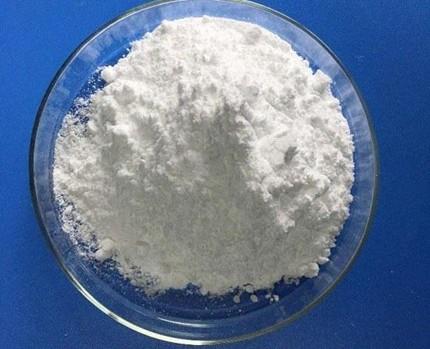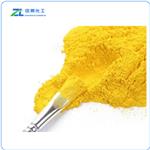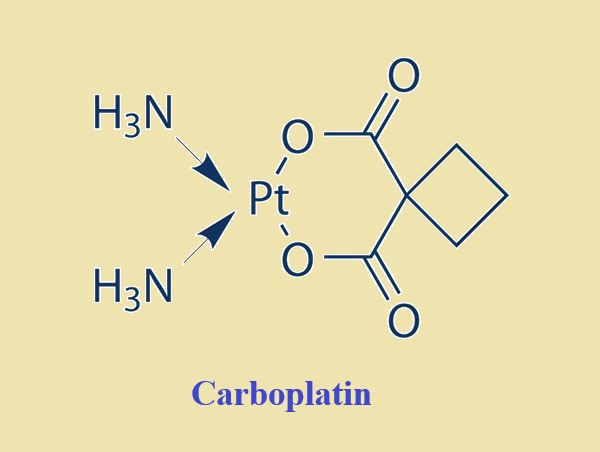Medical uses and Side effects of Carboplatin
Carboplatin is an antitumor agent containing a platinum metal complex that can induce abnormal cross-linking between the double helices of genetic material (DNA) in cancer cells, thereby interfering with their ability to utilize genetic material for growth or protein synthesis, ultimately inhibiting the continued proliferation and progression of cancer cells.

Figure 1:Picture of Carboplatin
General Description
Carboplatin, sold under the brand name Paraplatin among others, is a chemotherapy medication used to treat various forms of cancer such as ovarian cancer, lung cancer, head and neck cancer, brain cancer, and neuroblastoma. It is administered by injection into a vein, sometimes via a port. Side effects are common and can include low blood cell levels, nausea, and electrolyte problems. More serious side effects may involve allergic reactions and mutagenesis. While it may be carcinogenic, further research is needed to confirm this risk. Use during pregnancy can harm the baby. As a platinum-based antineoplastic drug, carboplatin works by interfering with DNA duplication. Developed as a less toxic alternative to cisplatin, carboplatin was patented in 1972 and approved for medical use in 1989. It is included on the 2023 World Health Organization's List of Essential Medicines. [1]
History
Carboplatin, a cisplatin analogue, was developed through a collaboration between Bristol Myers Squibb and the Institute of Cancer Research with the goal of creating a less toxic alternative to cisplatin. It received U.S. Food and Drug Administration (FDA) approval under the brand name Paraplatin in March 1989. Generic versions of the drug subsequently became available starting in October 2004. [1]
Medical uses
Carboplatin is used to treat various forms of cancer, including ovarian cancer, lung cancer, head and neck cancer, brain cancer, and neuroblastoma. It is also employed in treating triple-negative breast cancer and serves as an adjuvant therapy for stage 1 seminomatous testicular cancer. While it can be used for some types of testicular cancer, cisplatin is generally more effective for this purpose. Research indicates that for adjuvant therapy of stage 1 seminomatous testicular cancer, carboplatin is not less effective than adjuvant radiotherapy and has fewer side effects, leading to its general preference in clinical practice.
Mechanism of action
Carboplatin differs from cisplatin by having a bidentate dicarboxylate ligand in place of the two chloride ligands, though both are platinum-based antineoplastic drugs. The key distinction lies in carboplatin's slower chemical activation, where its ligand is replaced by water, resulting in slower DNA binding kinetics compared to cisplatin. Despite forming the same reaction products, the two drugs may operate through alternative mechanisms, as evidenced by causing different morphological changes in cell lines during their cytotoxic action. Carboplatin's diminished reactivity reduces protein binding and subsequent excretion, leading to a longer retention half-life of 30 hours in the body compared to cisplatin's 1.5 to 3.6 hours, making its effects longer lasting. Ultimately, like cisplatin, its primary mechanism is to bind to and cross-link DNA, thereby interfering with replication and suppressing cancer cell growth.
Dosage and Administration
For patients who have not been previously treated with Carboplatin and have normal renal function, a single dose of 400 mg/m² is administered either by short-term (15 to 60 minutes) intravenous injection or by continuous 24-hour infusion. A minimum interval of 4 weeks should be allowed before repeating the administration of Carboplatin.
Side effects
The primary advantage of carboplatin over cisplatin is its more favorable side effect profile, notably the absence of nephrotoxic effects and less severe, more manageable nausea and vomiting. However, the main drawback of Carboplatin is a significant myelosuppressive effect, which dramatically reduces the bone marrow's production of blood cells and platelets. This suppression typically reaches its lowest point 21–28 days after treatment before levels begin to stabilize. The resulting decrease in white blood cells, or neutropenia, increases the risk of infections from opportunistic organisms, often requiring hospital readmission and antibiotic treatment, and is sometimes managed with drugs like filgrastim. [2]
Reference
[1] Lebwohl D, Canetta R, Clinical development of platinum complexes in cancer therapy: an historical perspective and an update, Eur J Cancer. 1998, 34: 1522.
[2] Oun R, Moussa YE. The side effects of platinum-based chemotherapy drugs: a review for chemists, Dalton Transactions. 2018, 47:6645–6653.
Related articles And Qustion
See also
Lastest Price from Carboplatin manufacturers

US $0.00/g2025-04-21
- CAS:
- 41575-94-4
- Min. Order:
- 1g
- Purity:
- 99%
- Supply Ability:
- 1000 g

US $120.00/kg2025-04-15
- CAS:
- 41575-94-4
- Min. Order:
- 1kg
- Purity:
- 99%
- Supply Ability:
- 20ton


